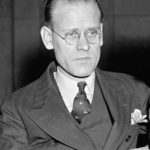Good morning, Whitewater.
It’s midweek already, and Wednesday in town will see thunderstorms and a high of eighty-four. Sunrise is 6:27 AM and sunset is 7:17 PM, for 12h 49m 46s of daytime. The moon is a waxing crescent with 31.2% of its visible disk illuminated.
The Summer Paralympics begin today in Rio. They’ll continue through September 18th.
On this day in 1927, Philo Farnsworth tests a version of television (an ‘image dissector’):
Philo Taylor Farnsworth (August 19, 1906 – March 11, 1971) was an American inventor and television pioneer.[2] He made many contributions that were crucial to the early development of all-electronic television.[3] He is perhaps best known for his 1927 invention of the first fully functional all-electronic image pickup device (video camera tube), the “image dissector“, as well as the first fully functional and complete all-electronic television system. He was also the first person to demonstrate such a system to the public.[4][5] Farnsworth developed a television system complete with receiver and camera, which he produced commercially in the form of the Farnsworth Television and Radio Corporation, from 1938 to 1951, in Fort Wayne, Indiana.[6][7]
In later life, Farnsworth invented a small nuclear fusion device, the Farnsworth–Hirsch fusor, or simply “fusor”, employing inertial electrostatic confinement (IEC). Although not a practical device for generating nuclear energy, the fusor serves as a viable source of neutrons.[8] The design of this device has been the acknowledged inspiration for other fusion approaches including the Polywell reactor concept in terms of a general approach to fusion design.[9] Farnsworth held 300 patents, mostly in radio and television….
Farnsworth worked out the principle of the image dissector in the summer of 1921, not long before his fifteenth birthday, and demonstrated the first working version on September 7, 1927, having turned 21 the previous August. A farm boy, his inspiration for scanning an image as series of lines came from the back-and-forth motion used to plow a field.[50][51] In the course of a patent interference suit brought by RCA in 1934 and decided in February 1935, his high school chemistry teacher, Justin Tolman, produced a sketch he had made of a blackboard drawing Farnsworth had shown him in spring 1922. Farnsworth won the suit; RCA appealed the decision in 1936 and lost.[52] Although Farnsworth was paid royalties by RCA, he never became wealthy. The video camera tube that evolved from the combined work of Farnsworth, Zworykin and many others was used in all television cameras until the late 20th century, when alternate technologies such as charge-coupled devices started to appear.[citation needed]
Farnsworth also developed the “image oscillite”, a cathode ray tube that displayed the images captured by the image dissector.[53]
Farnsworth called his device an image dissector because it converted individual elements of the image into electricity one at a time. He replaced the spinning disks with caesium, an element that emits electrons when exposed to light.
On this day in 1977, Wisconsin holds her first judicial recall election:
Dane County citizens voted Judge Archie Simonson out of office. Simonson called rape a normal male reaction to provocative female attire and modern society’s permissive attitude toward sex. He made this statment while explaining why he sentenced a 15-year-old to only one year of probation for raping a 16-year-old girl. After the recall election, Simonson was replaced by Moria Krueger, the first woman judge elected in Dane County history. [Source: Initiative & Referendum Institute].
Wednesday’s JigZone puzzle is of a kayak by a lake:

